Lady Esmerelda Peabody Wigglesworth and Squire Cleet Woolysocks set out from the capital; their mission given to them by his Royal Highness Boxelder Wimplesnatch the 4th? Remap the great kingdom of Tigomé and reconnect villages and cities all over the continent. The road would be hard and dangerous, much like the camp cookery of Squire Woolysocks, but the two of them, along with their horses Maple Stirrup and Fleabag, were well-suited for the job.
Wigglesworth had been a Cartographer of some renown before retiring to her family estates after an unfortunate incident with a feathered quill and a particularly challenging bit of coastline. Woolysocks on the other hand was more of a…people person; a charismatic, and handsome gentleman capable of spinning a yarn and charming even the most stubborn and reclusive townsfolk – Woolysocks also suffered from chronic flatulence, much to the chagrin of Fleabag.
Together, the two of them would represent the Guild of Merchant Explorers as they traveled across the harsh deserts, lush prairies, mountainous wastelands, treacherous seas, and mysterious Discovery towers of Tigomé, all in the name of the king – and of course money.

Guild of Merchant Explorers Overview
The Guild of Merchant Explorers is a competitive “flip and fill” game for 1-4 players. Over the course of 4 Eras, you’ll explore the kingdom of Tigomé, expanding out from your capital in search of treasure, undiscovered villages, and other exciting adventures. Each round you will flip over one of the Explore Cards, which feature one of four terrains (grassland, desert, mountains, and sea), and several other cards. The Explorer Cards dictate the terrain you must explore on that turn on your own personal map. Place an explorer piece on a shipwreck or ruin space and you’ll dig up a treasure, explore every space in a group of the same terrain and you’ll uncover a heretofore undiscovered village. At the end of 4 Eras the player who has amassed the most money will win the game, and the favor of good King Wimplesnatch the 4th.
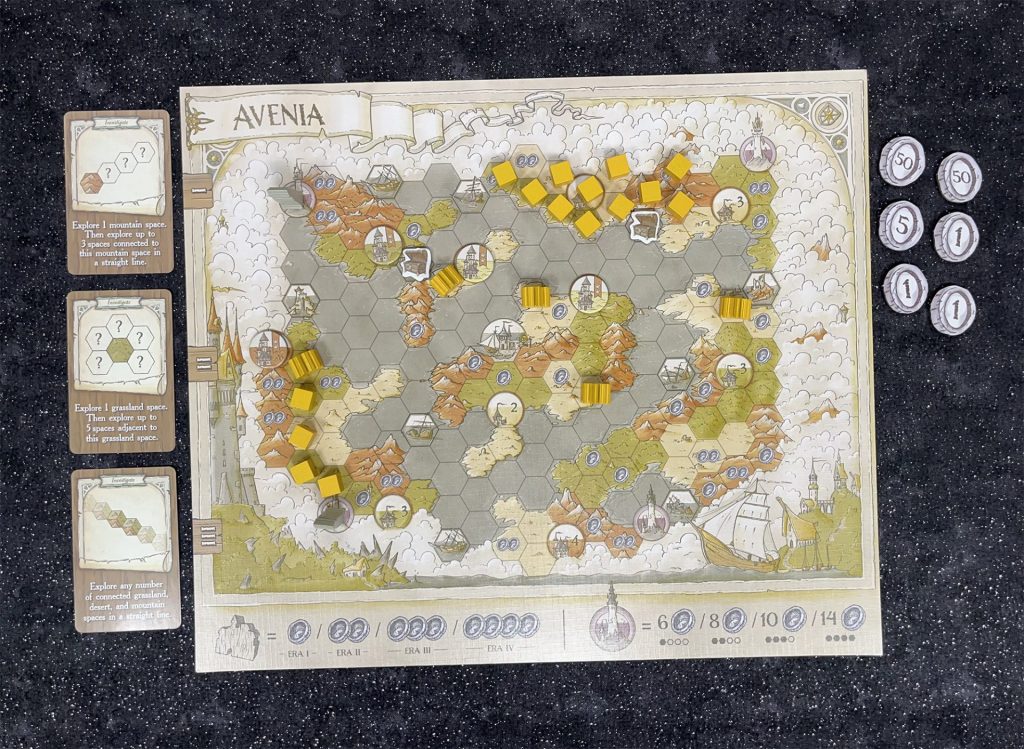
Setup, and a Sample Round
To set up The Guild of Merchant Explorers, give each player a set of explorer pieces, and one of the 4 different maps (and 2 additional maps with the expansion) so that each player has the same map name (Avenia, Aghon, Cnidaria, or Kazan).
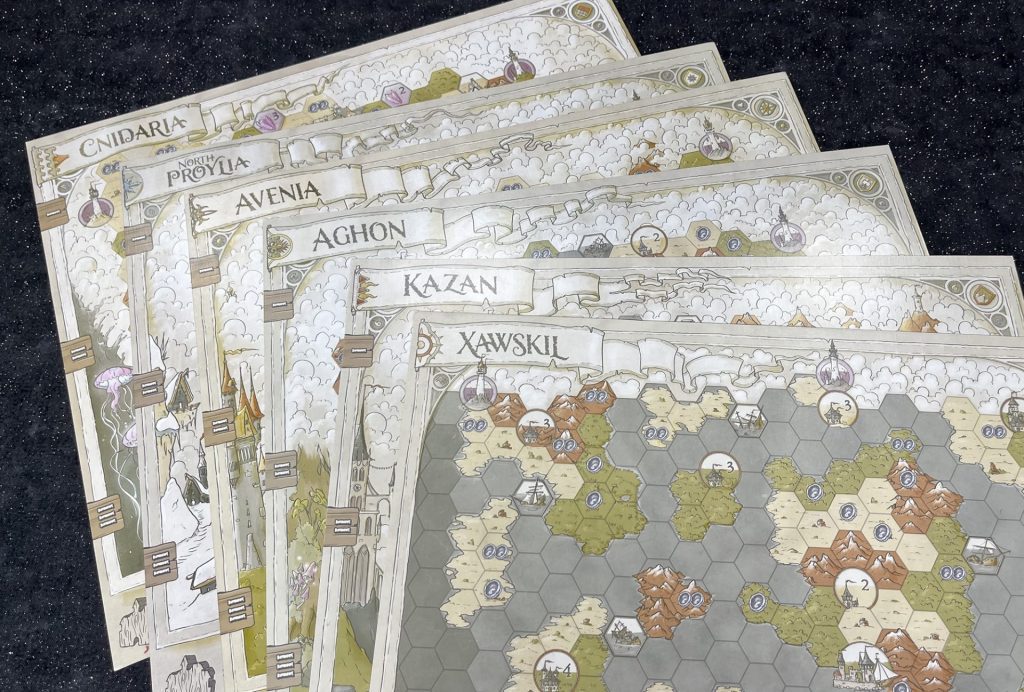
Place the discovery tower, trading post, treasure, coin, and crystal tokens in reach of all players. Shuffle the Treasure and Investigate cards and set them aside. Prepare the Explore deck by finding all 5 basic terrain cards, then adding in the first Era card. Shuffle them together, then place them on the Exploration board. Finally, pull out all 6 goal cards which match the map you’re using. Shuffle them, then deal 3 face up to be used as shared goals.
Traveling Without Moving
Turns in The Guild of Merchant Explorers are played simultaneously. As an Explore card is revealed, each player places Explorer markers onto their map obeying the 5 “Golden Rules of Exploration”:
- Each new Explorer marker must be placed next to an existing village, Explorer marker, or your capital.
- Explorer markers must be placed one at a time.
- Resolve map features as soon as they’re completed, even if you haven’t finished placing Explorers.
- Explorer markers may be placed on any valid space, anywhere on the map.
- You may choose to place fewer Explorer markers than indicated, but you can’t save extras for future turns.
Five of cards from the Explore deck are “basic” and represent simple terrain spaces (along with one wild). These cards are used in all 4 Eras. When you flip over a terrain card you place one or more Explorers on the terrain type indicated. In addition to the terrain restriction, each basic card also dictates how Explorer markers must be placed. Grassland and desert cards allow you to split your Explorer markers, while the sea and wild cards require your Explorer markers to be next to each other. The mountain card only allows you to place a single marker.
The other Explore cards are Era cards and are unique in that once drawn they give you a special ability which lasts the rest of the game. The first time an Era card is drawn, each player will draw 2 ability cards from the Investigate deck, then keep 1 and immediately use its ability. Then, on future turns, anytime that particular Era card is drawn you perform its special ability. Era cards are powerful and can allow you to rapidly expand in hopes of reaching distant shores before the end of an Era.
At the end of each Era (when all cards from the Explore deck have been revealed) players must recall all Explorers back to the capital. This leaves only village, treasure chest, and trade route markers on the board. It’s in your best interest to expand as quickly as possible and establish a village far away from the capital to allow yourself room for expansion.
Map Features, Discovery Towers, and Villages, Oh My!
As you expand outward from your capital, you’ll encounter various spaces on the map that aren’t just normal terrain. Let’s talk briefly about each of these and how they can, and should, work into your strategy.
Coins
Placing an Explorer on a coin spot allows you to immediately collect that number of coins.
Shipwrecks / Ruins
Covering up one of these spaces allows you to draw a treasure card, after which you’ll cover that space with a treasure chest token; marking it as inactive for the remainder of the game. Treasure cards are a mix of immediate bonuses (place an explorer, collect coins) and end game scoring (1 coin for every village, 1 coin for every discovery tower, etc.).
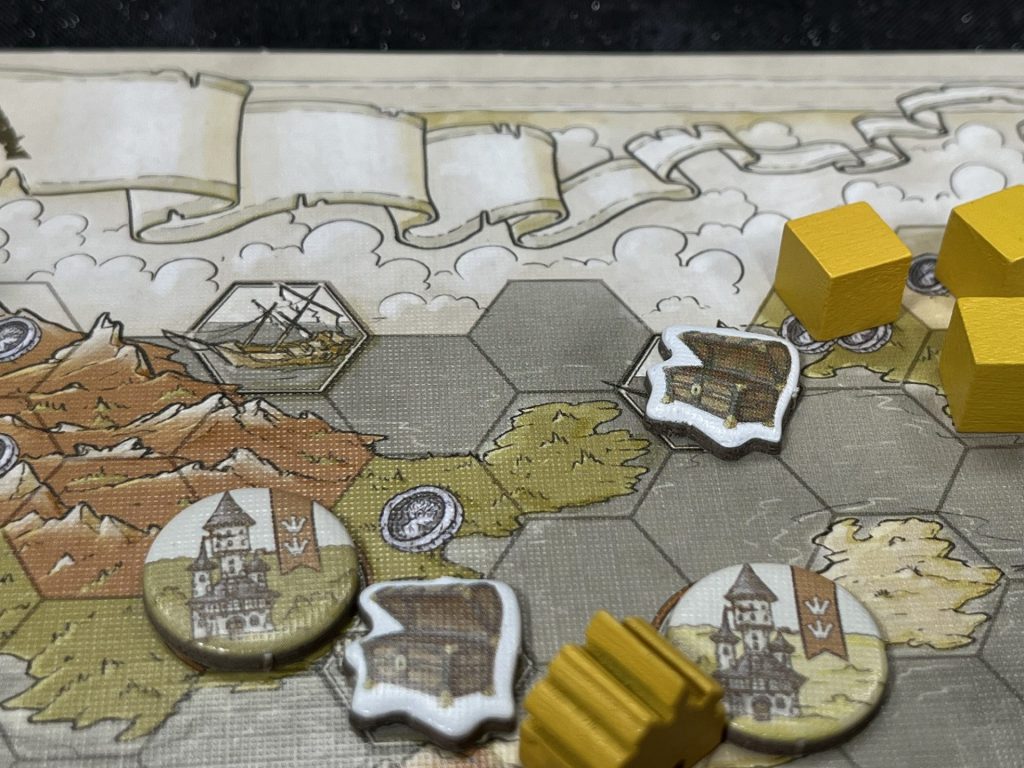
Discovery Towers
Each map has 4 Discovery Towers, placed roughly at the 4 corners of the map. A Discovery Tower is a “wild space” in that it can be explored using any terrain type. Exploring one of these spaces will earn you coins based on the number of towers you’ve explored. 1 tower earns you 6 coins, while the second will earn you another 8 coins, etc.
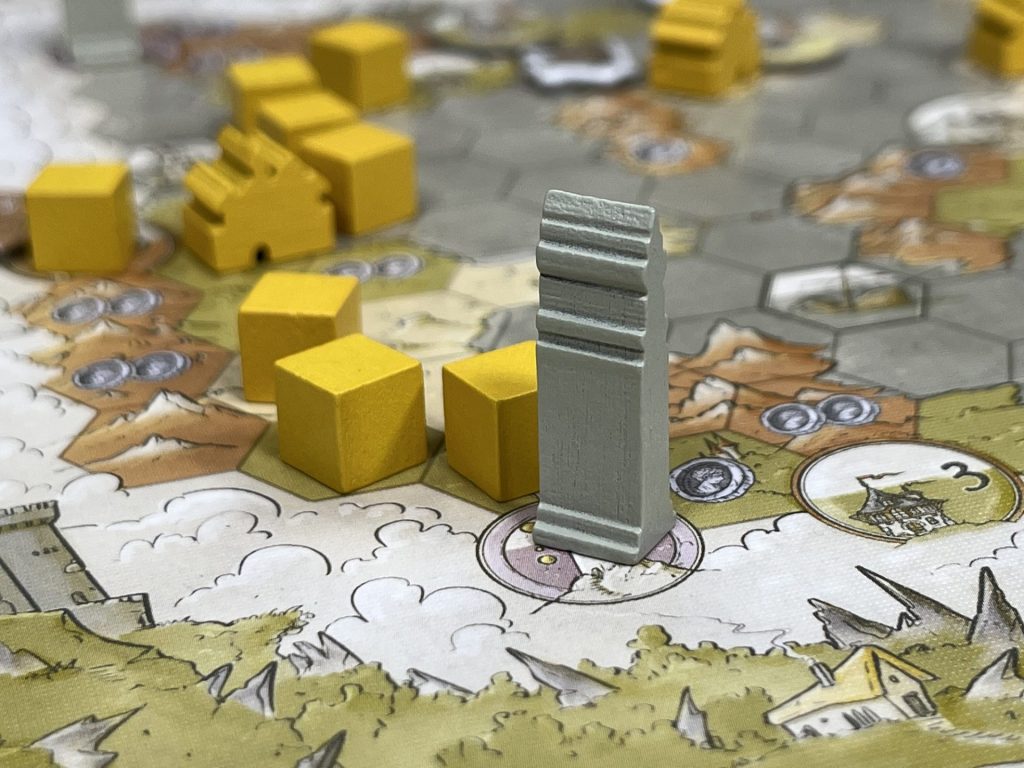
Cities / Trading Posts
Throughout your journeys, you’ll encounter cities, each one a potential trading partner for other cities in the kingdom. As you travel about the map you’ll be able to establish trade routes between any two cities which don’t already have trade route markers. Connect any two cities with an unbroken chain of explorers, then multiply the number of each city and collect that number of coins. Trade routes can be a valuable source of income, but you have to really focus on them, quickly branching out to other parts of the continent in order to ensure a ready supply of cities.
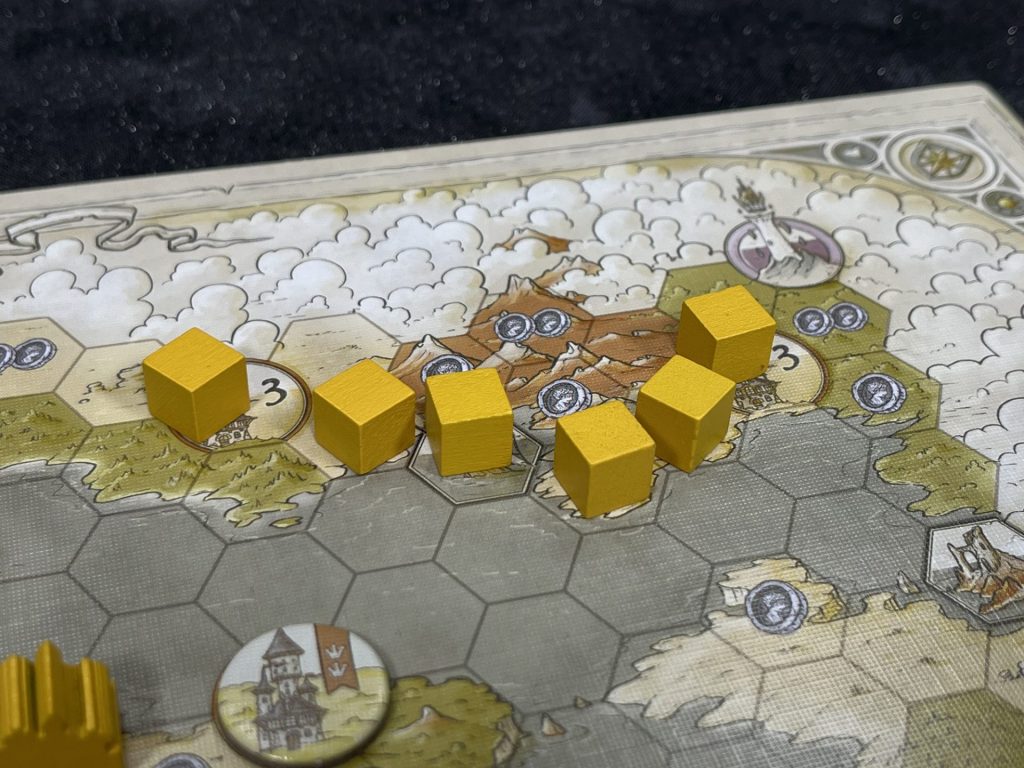
Villages
Each terrain type is represented by many different areas on the board, usually consisting of between 3 and 6 spaces. If at any time you’ve explored every space in a grouping of the same terrain types, you’ll discover a Village. Remove one of your Explorer markers and replace it with one of your Village markers. Villages can’t be placed on City or Coin spaces. Additionally you’ll earn coins equal to the current Era. Most importantly, Village spaces provide permanent locations for your Explorers to expand outward from. Establishing Villages early in the game, especially ones across the sea, will make it much easier to travel to the furthest reaches of your map where coin spots are more lucrative, and where you can explore Discovery Towers.
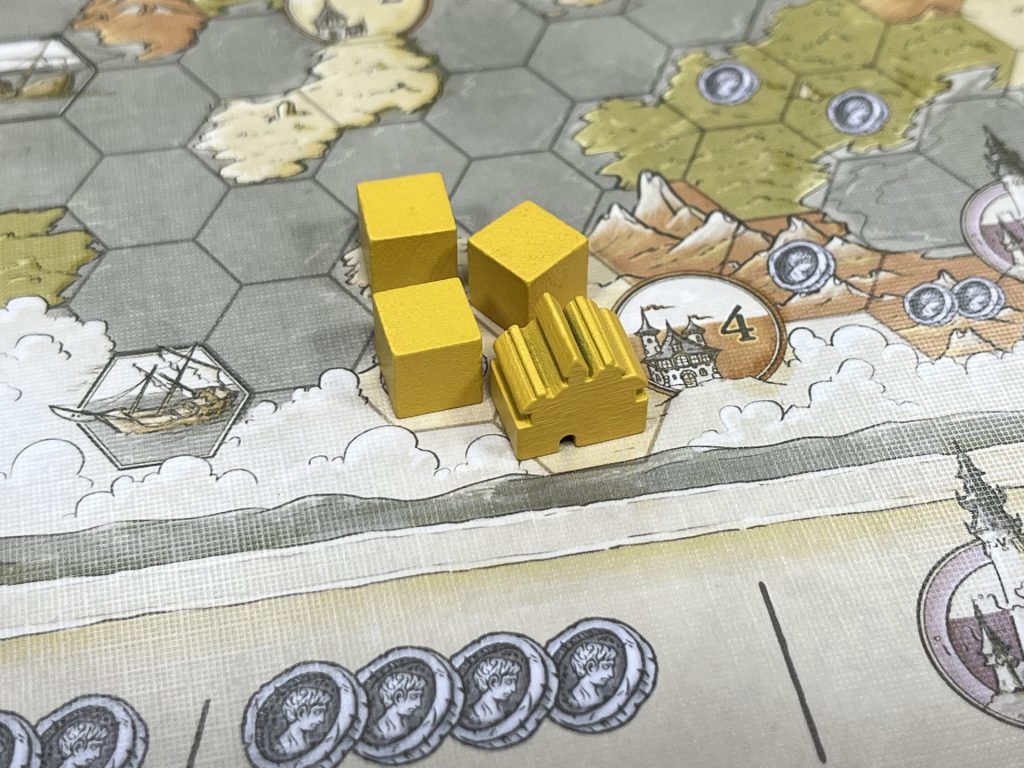
Goal Cards
Each map has 6 goal cards, with only 3 being used each game. Goal cards have two values: the first player to achieve the goal receives 10 coins, while any other player completing it earns only 5 coins. Goal cards are almost all about discovery: discover 5 villages, explore 3 Discovery Towers, search 4 ruin spaces along the edge of the board, etc. These are great for offering direction to new players, but can be tough to accomplish depending on the order cards are drawn and choices made in previous Eras.
Finishing the Game
At the end of the 4th Era players tally up their money along with any end-game bonuses earned from treasure cards. The player with the most money wins the game.
Final Thoughts on The Guild of Merchant Explorers
I feel like The Guild of Merchant Explorers came from out of nowhere. The first time I heard of it was a single mention on Twitter a few months ago. And then all of a sudden I had a review copy. I was very thankful because from everything I read about the game, it was going to be just my cup of tea. This game shares commonality with several games you’ve probably played, the most obvious one being Kingdom Builder, yet still has the feeling of a unique game.
The components of The Guild of Merchant Explorers are solid, if nothing flashy. The double-sided maps are printed on thick semi-glossy card stock and have a smooth, almost slick finish. The Explorer, Village, and Discovery Tower wooden pieces are well made, and the remainder of the pieces (all cardboard) are all thick and sturdy. My one main complaint about the components is that all the pieces are just about 25% too small. I understand that AEG likely made concessions due to price, but as someone with large hands it can sometimes be a challenge to pick up and handle small components. Not to mention that placing items on the map can be tricky when you’ve got other markers around the space you’re working with. This isn’t a deal breaker, but definitely something to consider.
The artwork is intricate, with thin lines and a muted color palette. The maps definitely give the impression of old maps, yellowed and dull with age, printed on vellum or old parchment. I’m no artist, but it certainly appears that every one of the map spaces was hand-drawn in place rather than being reused from a template. The attention to detail and willingness to take that extra time certainly paid off. The legend across the bottom indicating Village and Discovery Tower earnings is a welcome reminder as those rewards change regularly.
But what about the gameplay?
As much as I was really excited to play The Guild of Merchant Explorers, it fell a bit flat for me. Many games in the “roll and write” or “flip and fill” genre are largely solo affairs, even when playing with a full player count, and this one is no exception. There was almost zero player interaction, with the sole exception being the race to complete the goal cards. But even then the difference between 10 coins for being first, and 5 coins for everyone else, didn’t make much of a difference in scoring. In the 2 plays I had with 3 or 4 players, the scores were 119/129/133 and 110/119/134/142. I generally don’t mind games with light interaction but given that this game we’re all exploring “the same continent” it felt like there could have been something more.
I’m glad that Matthew and Brett chose to use cards vs dice for the Explore cards so that you’d know for certain that every card would be revealed, but the randomness of the draw pile contributed to some regular disappointments, as cards you didn’t want were revealed. You could say that means you should plan better, but when you’ve only played the game a handful of times it can be hard to know how to make those plans. My key takeaway from the card reveals was to expand to another shore as quickly as possible so as to give yourself more options and help mitigate unexpected terrain.
On my first play through I spent about 5 minutes trying to understand just how few Explorer markers I’d be placing on the board. Not counting the Investigate cards, the basic cards allow you to place a mere 10 cubes on the map. That felt paltry, until I drew my first Investigate card and realized that might allow me to place 5 or more cubes in a single turn. With a lucky draw you might get to use the Investigate card at least 3 more times. The Investigate cards are a great addition to the game, allowing you to flood an area with cubes, or even to expand in a straight line across entire sets of terrain. My only complaint is that some of these cards are clearly overpowered; for example, the card “Explore any number of connected grassland, desert, and mountain spaces in a straight line” allowed one player to place 9 or 10 cubes in a single turn. While the others are a more modest 3-5.

The Guild of Merchant Explorers benefits from familiarity: learning the gameplay, components, and strategies. But in the heavily crowded world of tabletop gaming you’ve gotta be able to hook people right out of the gate if you want staying power. And for me, The Guild of Merchant Explorers just didn’t do that.


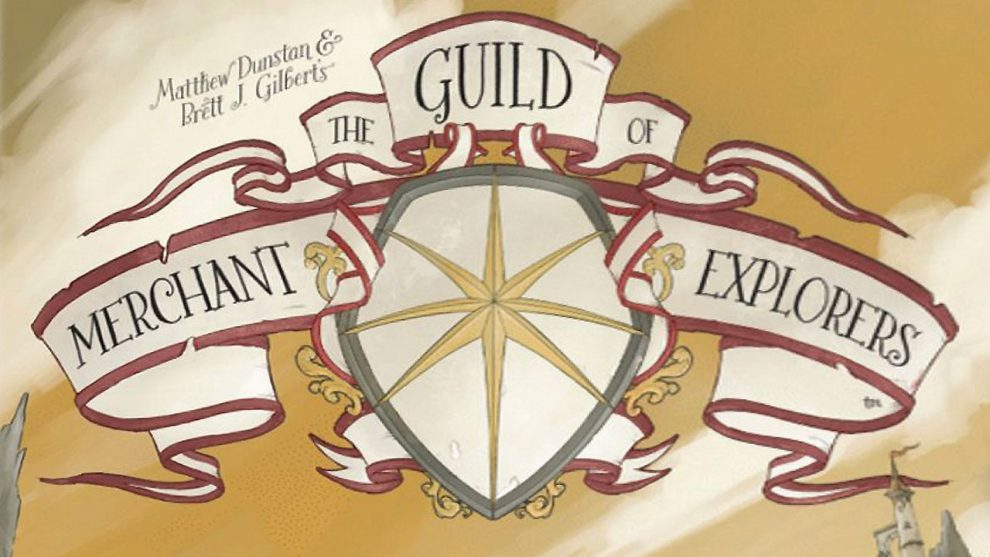









Add Comment